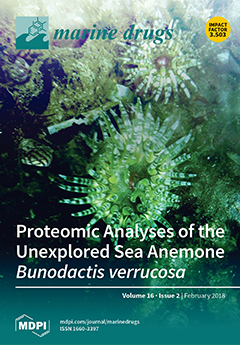1
Institute of Chemical Technology and Engineering, Faculty of Chemical Technology, Poznan University of Technology, Berdychowo 4, 61131 Poznan, Poland
2
Institute of Experimental Physics, TU Bergakademie-Freiberg, Leipziger str. 23, 09559 Freiberg, Germany
3
Natural Products Unit, King Fahd Medical Research Center, King Abdulaziz University, Jeddah 21589, Saudi Arabia
4
Suez Canal University Hospital, Suez Canal University, Ismailia 41522, Egypt
5
Department of Natural Products, Faculty of Pharmacy, King Abdulaziz University, Jeddah 21589, Saudi Arabia
6
Department of Pharmacognosy, Faculty of Pharmacy, Suez Canal University, Ismailia 41522, Egypt
7
Leibniz Institute of Polymer Research Dresden, 01069 Dresden, Germany
8
P.P. Shirshov Institute of Oceanology of Academy of Sciences of Russia, 117997 Moscow, Russia
9
Faculty of Medicine Carl Gustav Carus, Dresden University of Technology, 01307 Dresden, Germany
10
Department of Invertebrate Zoology, Biological Faculty, Lomonosov Moscow State University, 119992 Moscow, Russia
11
Institute of Clinical Chemistry and Laboratory Medicine, University Hospital Carl Gustav Carus, Medical Faculty Carl Gustav Carus, Technische Universität Dresden, 01307 Dresden, Germany
12
Institute of Electronics and Sensor Materials, TU Bergakademie Freiberg, 09599 Freiberg, Germany
add
Show full affiliation list
remove
Hide full affiliation list
Abstract
Sponges (Porifera) are recognized as aquatic multicellular organisms which developed an effective biochemical pathway over millions of years of evolution to produce both biologically active secondary metabolites and biopolymer-based skeletal structures. Among marine demosponges, only representatives of the Verongiida order are known to
[...] Read more.
Sponges (Porifera) are recognized as aquatic multicellular organisms which developed an effective biochemical pathway over millions of years of evolution to produce both biologically active secondary metabolites and biopolymer-based skeletal structures. Among marine demosponges, only representatives of the Verongiida order are known to synthetize biologically active substances as well as skeletons made of structural polysaccharide chitin. The unique three-dimensional (3D) architecture of such chitinous skeletons opens the widow for their recent applications as adsorbents, as well as scaffolds for tissue engineering and biomimetics. This study has the ambitious goal of monitoring other orders beyond Verongiida demosponges and finding alternative sources of naturally prestructured chitinous scaffolds; especially in those demosponge species which can be cultivated at large scales using marine farming conditions. Special attention has been paid to the demosponge
Mycale euplectellioides (Heteroscleromorpha: Poecilosclerida: Mycalidae) collected in the Red Sea. For the first time, we present here a detailed study of the isolation of chitin from the skeleton of this sponge, as well as its identification using diverse bioanalytical tools. Calcofluor white staining, Fourier-transform Infrared Spcetcroscopy (FTIR), electrospray ionization mass spectrometry (ESI-MS), scanning electron microscopy (SEM), and fluorescence microscopy, as well as a chitinase digestion assay were applied in order to confirm with strong evidence the finding of a-chitin in the skeleton of
M. euplectellioides. We suggest that the discovery of chitin within representatives of the
Mycale genus is a promising step in their evaluation of these globally distributed sponges as new renewable sources for both biologically active metabolites and chitin, which are of prospective use for pharmacology and biomaterials oriented biomedicine, respectively.
Full article






